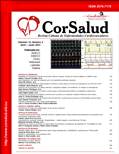Umbilical vein draining directly into the right atrium: A case report
Abstract
The ductus venosus agenesis is a rare condition associated with adverse perinatal outcomes. We present the case of a fetus of 23.4 weeks that was studied at the Department of Fetal Cardiology in the Cardiocentro Pediátrico William Soler. The four-chamber cross-sectional view echocardiogram showed cardiomegaly with a predominance of right chambers. After performing a longitudinal section of the fetus by color Doppler superimposed on the two-dimensional image, we could trace the course of the umbilical vein draining directly into the right atrium. The newborn underwent a CT scan and the presence of congenital digestive defects was diagnosed. In the case of suspected absence of ductus venosus it is important to determine the drainage variant, identify “microarrays”, and look for structural malformations and genetic diseases since prognosis will depend on all these factors.
Downloads
References
1. Maruotti GM, Saccone G, Ciardulli A, Mazzarelli LL, Berghella V, Martinelli P. Absent ductus venosus: case series from two tertiary centres. J Matern Fetal Neonatal Med. 2018;31(18):2478-83. DOI: https://doi.org/10.1080/14767058.2017.1344637
2. Berg C, Kamil D, Geipel A, Kohl T, Knöpfle G, Hansmann M, et al. Absence of ductus venosus-importance of umbilical venous drainage site. Ultrasound Obstet Gynecol. 2006;28(3):275-81. DOI: https://doi.org/10.1002/uog.2811
3. Pérez-Pedregosa J, Martínez MT, del Pino S, Gutiérrez-Larraya F, Medina L, Bueso T, et al. Diagnóstico prenatal y evolución en fetos con agenesia de ductus venoso. Rev Chil Obstet Ginecol. 2014;79(3):173-81. DOI: http://doi.org/10.4067/S0717-75262014000300005
4. Oliva J. Ultrasonografía diagnóstica fetal, obstétrica y ginecológica. ECIMED. La Habana; 2010.
5. García Guevara C, Araluce Calderíus M, García Lugo W, Arencibia Faife J, Hernández Y, Mitzi JC. Agenesia de ductus venoso: Presentación de un caso. Rev Fed Arg Cardiol. 2019;48(3):127-9.
6. Oztunc F, Gokalp S, Yuksel MA, Imamoglu M, Madazli R. Absent ductus venosus in the fetus. J Obstet Gynaecol. 2014;34(8):741-2. DOI: https://doi.org/10.3109/01443615.2014.930105
7. Moaddab A, Tonni G, Grisolia G, Bonasoni MP, Araujo Júnior E, Rolo LC, et al. Predicting outcome in 259 fetuses with agenesis of ductus venosus - A multicenter experience and systematic review of the literature. J Matern Fetal Neonatal Med. 2016;29(22):3606-14. DOI: https://doi.org/10.3109/14767058.2016.1144743
8. Sau A, Sharland G, Simpson J. Agenesis of the ductus venosus associated with direct umbilical venous return into the heart - Case series and review of literature. Prenat Diagn. 2004;24(6):418-23. DOI: https://doi.org/10.1002/pd.882
9. Ayerza Casas A, López Ramón M, Pérez Pérez P, Rite Gracia S, Palanca Arias D y Jiménez Montañés L. Evolución cardiológica postnatal y factores asociados a la agenesia de ductus venoso de diagnóstico prenatal. Rev Colomb Cardiol. 2018;25(4):282-5. DOI: http://doi.org/10.1016/j.rccar.2018.02.008
10. Horie K, Takahashi H, Matsubara D, Kataoka K, Furukawa R, Baba Y, et al. Absent ductus venosus associated with partial liver defect. Case Rep Obstet Gynecol [Internet]. 2018 [citado 24 May 2020];2018:6591025. Disponible en: https://doi.org/10.1155/2018/6591025
Downloads
Published
How to Cite
Issue
Section
License
Authors who publish with this journal agree to the following terms:- Authors retain copyright and grant the journal right of first publication with the work simultaneously licensed under a Creative Commons Attribution License that allows others to share the work with an acknowledgement of the work's authorship and initial publication in this journal.
- Authors are able to enter into separate, additional contractual arrangements for the non-exclusive distribution of the journal's published version of the work (e.g., post it to an institutional repository or publish it in a book), with an acknowledgement of its initial publication in this journal.










